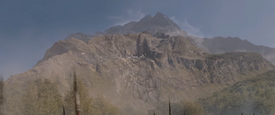
The Dwimorberg as it appears in Peter Jackson's The Lord of the Rings: The Return of the King
The Dwimorberg was a brooding black[1] mountain that was situated to the east of the Firienfeld in Dunharrow[2] at the head of the valley of Harrowdale in the center of the White Mountains[3][4].[5]
Dunharrow stood above a cliff on the valley's eastern side,[5] parallel to the mountain itself.[6] Beyond Dunharrow was a collection of somber pines and firs on the lower slopes of the mountain. Some of these dark trees[7] formed a forest known as the Dimholt.[5] This forest contained a hollow place which held a mightly standing stone that lay in front of a deep glen with a doorway leading inside the Paths of the Dead.[1]
History[]
During the Second Age, the Men of the Mountains swore an oath to Isildur, King of Gondor in those days. But their fathers had worshiped Sauron in the Dark Years, and still had some love for him, and so when called upon to fulfill their oath to Gondor, they would not, and so Isildur cursed them, never to rest until they had fulfilled their oaths.[1]
During the late Third Age, it was believed by the Rohirrim that the Dwimorberg was haunted by the spirits of the Men of the Mountains, who would occasionally enter the valley of Harrowdale like shadows, bringing with them a great unquiet as well as death.[5]
Aragorn II eventually allowed them to finally fulfill their oath, and they were released to go in peace. After the great events at the end of the Third Age, Dwimorberg was haunted no longer.
Etymology[]
Dwimorberg was a name in Old English meaning "Haunted Mountain" or "Phantom Mountain",[2] consisting of the words dwimor ("phantom, ghost, illusion, delusion, apparition")[8][9][10] and beorg ("mountain").
Translations[]
| Foreign Language | Translated name |
| Amharic | ድዊሞርበርግ |
| Arabic | دفيموربرغ |
| Armenian | Դվիմորբերգը |
| Belarusian Cyrillic | Дўіморберг |
| Bengali | দ্বিমরবের্গ |
| Bulgarian Cyrillic | Дщиморберг |
| Chinese (Hong Kong) | 丁默山 |
| Danish | Spøgelsesbjerget |
| Georgian | დვმოორბერგი |
| Greek | Δωιμορβεργ |
| Gujarati | ડ્વિમોર્બર્ગ |
| Hebrew | דווימורברג |
| Hindi | ड्विमोर्बेर्ग |
| Kannada | ಡ್ವಿಮೋರ್ಬರ್ಗ್ |
| Kazakh | Двиморберг (Cyrillic) Dvïmorberg (Latin) |
| Kyrgyz Cyrillic | Двиморберг |
| Macedonian Cyrillic | Двиморберг |
| Marathi | ड्विमॉर्गबर्ग |
| Mongolian Cyrillic | Двиморбэрг |
| Nepalese | ड्वाइमबर्ग |
| Pashto | ضویموربېرګ ? |
| Persian | دویموربرگ |
| Punjabi | ਡਵਿੱਮਬਰਗ |
| Russian | Двиморберг |
| Sanskrit | ड्विमोर्बेर्ग् |
| Serbian | Дwиморберг (Cyrillic) Dwimorberg (Latin) |
| Sinhalese | ඩිවිමෝර්බර්ග් |
| Tajik Cyrillic | Двиморберг |
| Tamil | தவிமோர்பேர்க் |
| Telugu | ద్విమోర్బెర్గ్ |
| Ukrainian Cyrillic | Двіморберг |
| Urdu | دویموربرگ |
| Uzbek | Дwиморберг (Cyrillic) Dwimorberg (Latin) |
| Yiddish | דווימאָרבערג |
References[]
- ↑ 1.0 1.1 1.2 The Lord of the Rings, Vol. III: The Return of the King, Book Five, Ch. II: "The Passing of the Grey Company", pg. 59
- ↑ 2.0 2.1 The Lord of the Rings: A Reader's Companion, "Unfinished index for The Lord of the Rings", pg. 533 (entry Dwimorberg)
- ↑ The Lord of the Rings, "The West of Middle-earth at the End of the Third Age" (map)
- ↑ The Lord of the Rings, Vol. III: The Return of the King, "Map of Rohan, Gondor, and Mordor"
- ↑ 5.0 5.1 5.2 5.3 The Lord of the Rings, Vol. III: The Return of the King, Book Five, Ch. III: "The Muster of Rohan", pgs. 68-70
- ↑ The Atlas of Middle-earth, Regional Maps, "The White Mountains"
- ↑ The Lord of the Rings: A Reader's Companion, "Nomenclature of The Lord of the Rings", pg. 768 (entry Dimholt)
- ↑ The Lord of the Rings: A Reader's Companion, pg. 404
- ↑ The Lord of the Rings: A Reader's Companion, "Unfinished index for The Lord of the Rings", pg. 562 (J.R.R. Tolkien's comment on dwimmerlaik in the 1966 The Lord of the Rings index)
- ↑ The History of Middle-earth, Vol. VIII: The War of the Ring, Part Three: "Minas Tirith", IX: "The Battle of the Pelennor Fields", pg. 372 (note 2)
